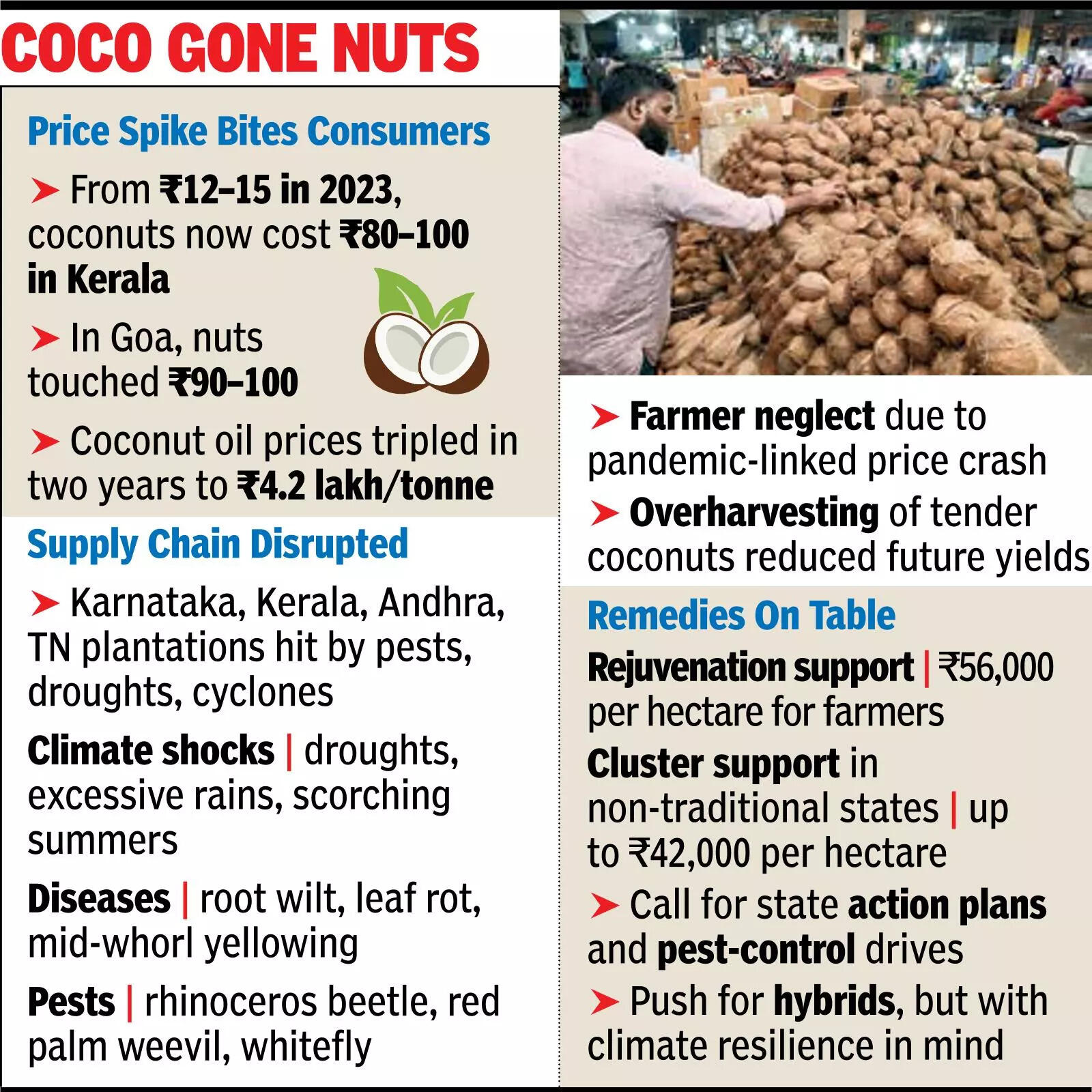PANAJI/ KOCHI: As foam-tipped waves licked Goa’s Miramar seashore, a vacationer reached for a young coconut to beat the afternoon blaze. “Rs 90,” mentioned the seller. The vacationer blinked. “For one? Wasn’t it Rs 40 final yr?” As soon as a simple indulgence, the standard coconut has changed into a luxurious in a lot of India’s south, with costs up from Rs 15-25 simply two years in the past to anyplace between Rs 80 and Rs 100 now.In Kerala, the disaster has a phrase: “Moongan irunna naayudey thalayil thenga veenu.” A coconut falling on the top of a canine that was already in search of an excuse to cry. Hassle piling onto hassle.Right this moment’s scarcity will be traced to the pandemic years. Tender coconut gross sales collapsed in 2020-21 as provide chains froze, resulting in over-mature nuts and a glut by 2022-23, crashing costs and discouraging take care of bushes. “Farmers did not replant after the 2023 crash. Now yields have dropped and restoration takes years,” mentioned farmer-producer group member Sunil Cyriac. Misplaced time can’t be reclaimed in a single season. Tall bushes want 5 to eight years to bear fruit. Shorter hybrids, three.

Climatic swings – heavy rain in 2022, drought in 2023, scorching warmth in 2024-25 – left plantations reeling in Karnataka. Pests broken 30% of output in Tumakuru, Mandya, Hassan, Chikkamagaluru and Chitradurga. Cyclonic harm and pest assaults hit 25% of plantations in Andhra Pradesh. In TN, root wilt illness and whitefly infestation worn out 40% of yields in Krishnagiri and Tirunelveli.Kerala confronted leaf rot illness in central and northern zones and mid-whorl yellowing in south, resulting in irregular nut fall and tree loss of life. Rhinoceros beetles and purple palm weevils added to the devastation.The competition season – Onam in Kerala, Ganesh Chaturthi nationwide – despatched the market right into a spiral. Copra, oil and contemporary nut costs have soared as shortages deepen. Panaji market vendor Sulagna Gaunekar blamed excessive labour and transport prices. Tourism added stress, with tender coconuts overharvested for fast income, reducing into subsequent yr’s yield. Goa’s agriculture director Sandeep Fol Dessai cited a mixture of pests, fungal infections and “monkey menace”. He mentioned as farmers migrated to cities, leaving plantations unattended, “Monkeys destroyed crops.” Manufacturing for 2024-25 stood at 1,508 lakh nuts – far wanting demand. Goa Horticulture Company rushed in 75,000 coconuts from Karnataka, promoting at a subsidised Rs 40-45. They offered out in hours.Officers mentioned the disaster was international. Indonesia, Philippines, Thailand and Sri Lanka additionally noticed a drop in output. “Value fluctuation had associated elements – crop neglect and local weather variation,” mentioned Coconut Growth Board advertising director Deepthy Nair.Coconut oil costs mirrored the pressure – Rs 4,23,000 per metric tonne in India, almost triple in two years, in accordance with a Reuters report. Worldwide manufacturing flatlined at 3.67 million tonnes in 2024-25, the US agriculture dept reported.At seashores, markets and temples, coconuts now carry the load of local weather change, fungus, beetles, neglect and damaged provide chains – all packed right into a single onerous shell. India stays the world’s largest producer, with an estimated 15 million metric tonnes for 2024-25, in accordance with Coconut Growth Board. Karnataka leads with 28.5% of output, adopted by Kerala, TN and Andhra Pradesh.

